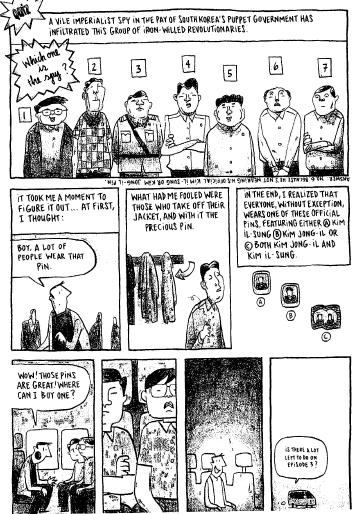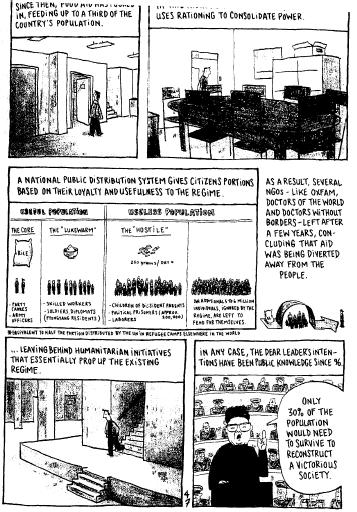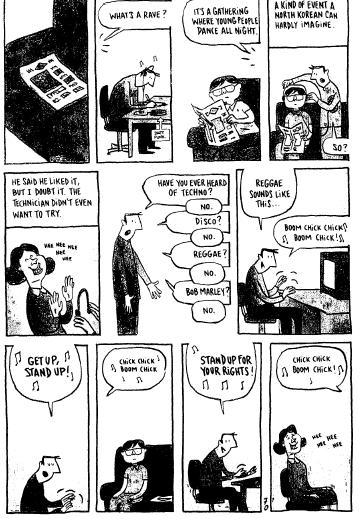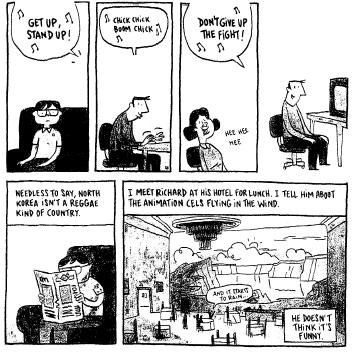Review: ‘Pyongyang: A Journey in North Korea,’ by Guy DeLisle
 Please — not another travelogue of tyranny tourism in North Korea.
Please — not another travelogue of tyranny tourism in North Korea.
In the last several years, dozens of con-men, apologists, and petty tyrants have described North Korea as a great place to golf, bowl, get rich quick, or profit by displaying the misery of others. Three U.N. aid workers published a fine dining guide, just as the last mass graves of the Great Famine were filled. A UNICEF worker recently lamented that North Korea was unfairly stereotyped. A Korean-American unificationista was shocked to see hungry street orphans, but placed the blame on a cruel U.S. trade “embargo.” Jane Goodall lent her good name to North Korea’s claims to be a steward of the environment. At each year’s “Arirang” festival, liberal thinkers rave about the transformation of thousands of human beings into pixels and go home to their Volvo wagons, whose bumpers bear slogans like “Question Authority” and “Kill Your Television.” An ABC News reporter was so thrilled to be there that he forgot to ask any real questions. Ted Turner went off his medication against medical advice. All those people shared two things: pretty much the same short-track itinerary and an absence of curiosity about unscheduled venues, or dark rumors about the events occurring there.
A report is as good as its reporter.
=================
Fortunately, Guy DeLisle’s graphic novel (a fancy term for a book-length comic strip), “Pyongyang: A Journey in North Korea,” will go far to make up for all of that. But please, whatever you do, Do not, under any circumstances, take this book to North Korea! Page 73 contains a caricature of the moment of the Great Leader’s conception, which made me laugh so hard I almost had an aneurism right there on the Metro. The North Korean authorities will not be equally amused.
=================
Delisle, a French-Canadian animator, begins this animated travel journal in the unlit lobby of Pyongyang’s airport as he begins a two-month assignment working with a local animation studio. Apparently, a number of French studios are outsourcing work to North Korea, including some that produce product for Disney. DeLisle’s guide picks him up at the airport and hands him a bouquet of flowers the author already senses aren’t for him. The guide — DeLisle won’t be without one accompanying or observing him for his entire two-month trip — loads him into a van, cranks the A/C, and starts chain-smoking. Their destination will be the “highest point in the city,” which also turns out to be the first of a series of overwrought monuments to Kim Il Sung to which the guides will drag their exasperated charge. Here, DeLisle’s suspicions are confirmed. He is expected to leave the flowers for you-know-who.
Deslisle doesn’t accept stultifying mind-control glibly.

Often, he is simultaneously horrified and barely able to contain his laughter. Where are all the handicapped people? “All North Koreans are born strong and healthy.” Didn’t you like Paris? “Dirty and full of beggars.” Looking at his minders, he wonders, “Do they really believe the bullshit that’s being forced down their throats?,” and answers his own question. Those isolated in the countryside probably do, he speculates, but for everyone else, a “mute, hidden terror” renders truth irrelevant: “The greater the lie, the greater the show of power.”
Delisle understands this because he’s done his homework. He describes the origins of the regime and its leaders, the personality cult, and the punishment of entire families that turns love into a prison for the soul. He has also researched the causes of the famine:

Contrast this with the waste Delisle sees everywhere: the gargantuan shell that was to be the Ryugyong hotel, the full-page ad the regime placed in the New York Times in 1997 (the height of the famine), the enormous theater that seldom shows movies, unused superhighways that go nowhere but to monuments to Kim Il Sung. A building’s construction crawls along at a snail’s pace, but noisy propaganda music drowns the entire neighborhood surrounding the work site. A bridge is half-painted, forgotten, and soon rusts through again.
Delisle dabbles in the subversive, too. He smuggles in a radio and a copy of “1984,” which he even lends to a North Korean acquaintance (a move that could have endangered both of them). His passages about reading “1984” in Pyongyang are some of the book’s best moments. Here is another:


Eventually, Delisle, who hates Coca-Cola, comes to view drinking it as an act of rebellion. And Delisle is equally immune to North and South Korean propaganda about reunification:

“Pyongyang: A Journey in North Korea” doesn’t aspire to erudition. It consists of the plain-spoken, easy-reading observations of an intelligent and skeptical man who saw things that were horribly wrong and took the trouble to explain them. Sometime after my kids are in school, I’ll write a review of Bradley Martin’s fascinating — but very long — tome. Meanwhile, no other book will teach you more about North Korea in less time, or to make you laugh so hard or think so much as you read it, as this one.
The whole thing will take two hours to read. Set those hours aside; you won’t want to be interrupted. “Pyongyang: A Journey in North Korea” is a must-read from page one to its inspired ending.
I thoroughly agree with your review. It’s an incredibly poignant book with spot-on observations from a rare insider.
May I suggest: “Comrades and Strangers : Behind the Closed Doors of North Korea” by Michael Harrold as another riveting read?
a book review is only as good as the reviewer.
i may even buy that book now.